|
1998. First picture of an
oro-nasal fistula in a
dog
taken by Dr Sing.
One of my first attempt at digital photography
to start "Be Kind To Pets" community education
for surfers |
2003. "Doctor, put this old dog to sleep because
he bites my only son!"
The Old Spitz bites in self defence |
2005. Bad breath in older
dogs and pictures of teeth scaling.
Pictures of a case |
| |
|
|
|
2007. The young man knew why his
8-year-old Whippet felt pain in his cheek
and could not eat.
Taking mum's dog to the vet |
2007. Pom's facial wound
never heals. Why?
Oro-nasal fistula. |
|
| |
|
|
|
2008. Epileptic fits in an
old Miniature Bull Terrier is attributed to dental
diseases |
|
Is chronic
periodontal disease a primary cause of epilepsy in this
Miniature Bull Terrier?
|
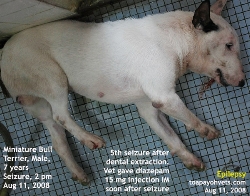 |
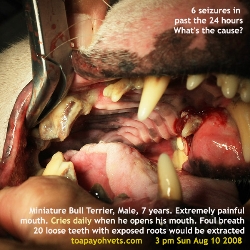 |
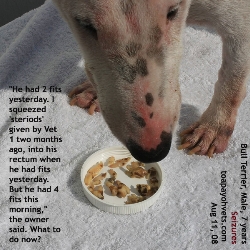 |
|
Cluster of seizures continued. Blood test
with a high white cell count indicated a
bacterial infection. |
Dog had much less painful mouth. 4 canine
teeth & 1 molar teeth remained. 20 loose teeth
extracted. |
I saw him on May 5, 2009. He had not taken
anti-epilepsy medication for over the past
3 months and had no fits after a 2nd
dental extraction to remove the remaining 4 canine
and 1 molar teeth which were slightly
loose and not extracted during the first dental
treatment.
In this case, the cause of fits could be
attributed to oral pain and infection as
the dog did not have any fits for the next
few months. He went jogging with his
master daily. One day, he swallowed his
lease and had an injection to vomit the
leash. No more complaints of fits in 2009 after
all his teeth were extracted. He continued jogging
with his master till he passed away of other
causes in 2010. Details are at:
When your beloved jogging companion suffers from
epilepsy. |
| |
|
|
|
2008. Anaesthetic risks in old dogs
having dental scaling |
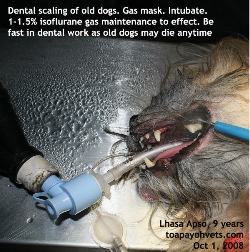 |
The lady owner agonised over whether to get dental work done by the
veterinarian and risk losing her dog to anaesthetic death as the dog
was 9 years old. Dog was OK.
Dogs over 5 years old. There is always the risk of
death from anaesthesia. Therefore, some owners do not want any dental
work on their old dogs, preferring loose teeth, smelly mouth, infected
gums and mouth ulcers and tumours.
|
| |
Each owner has to decide whether to take the anaesthetic risks to get
the dog dental treatment so that he or she has a better quality of
life and not carry bacterial infections which ultimately affect the
heart valves and other internal organs.
|
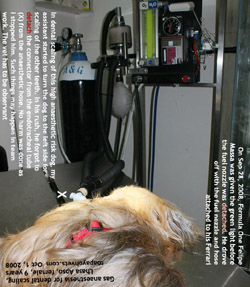 |
Try to get dental scaling done when your dog is less than 5 years old
and brush his teeth after scaling at least 3x/week. 3 loose decayed
teeth extracted in this well loved 9-year-old Lhasa Apso.
She still has many good
strong teeth. The concerned young lady will use tooth-brushing to prevent tartar
formation. Tartar formation will recur
if the owner does not brush the dog's teeth after scaling and dental
work. I don't perform "manual scaling" without general anaesthesia.
Ultrasonic dental scaling is preferred as the dog
is not stressed or frightened and it does a better
job . General anaesthesia is used in all cases.
There has only been one exception to this practice
as the dog had heart diseases and was very old.
The case study is at:
|
|
2009. A 6-year-old Pomeranian with heart has
dental work |
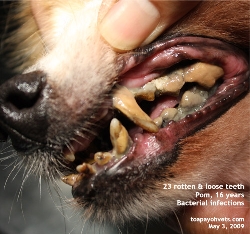 |
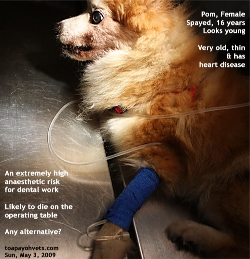 |
|
| |
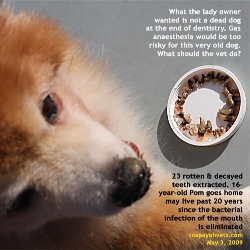 |
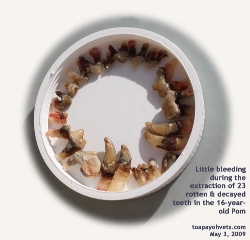 |
|
3-year-old dog has dental scaling |
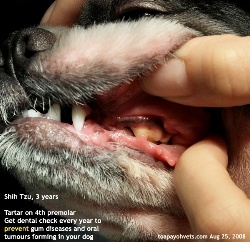 An annual
dental health check up is recommended for dogs older than
2 years old.
Use a finger brush to clean your
dog's teeth after scaling if your dog fights you
when you use the toothbrush. An annual
dental health check up is recommended for dogs older than
2 years old.
Use a finger brush to clean your
dog's teeth after scaling if your dog fights you
when you use the toothbrush.
Start from a young age. You may need to bribe the
dog with a "toothpaste" he likes rather than the
commercial ones he dislikes. See a case in Jun
2010 at:
The Bichon Frise had an exposed
root of the 3rd pre-molar tooth
|
 TOA
PAYOH VETS
TOA
PAYOH VETS TOA
PAYOH VETS
TOA
PAYOH VETS